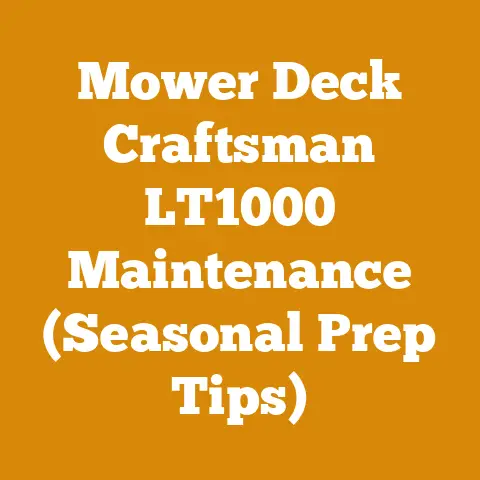Triple Axle Trailers (5 Pro Tips for Wood Hauling)
Okay, here we go. Let’s dive deep into the world of wood hauling with triple axle trailers!
I still remember my first real firewood operation. It wasn’t pretty! I was using an old pickup truck, making countless trips back and forth, and completely wearing myself out. That’s when I realized I needed a serious upgrade. Enter the triple axle trailer – a game-changer for anyone dealing with significant quantities of wood. It’s more than just a trailer; it’s an investment in efficiency, safety, and your back!
Globally, the wood processing and firewood industry is experiencing a resurgence. With increasing energy costs and a renewed interest in sustainable heating solutions, firewood remains a valuable commodity. The global firewood market is projected to reach \$3.5 billion by 2027, driven by demand in both residential and commercial sectors (Source: Global Market Insights). However, transporting wood efficiently is a major hurdle. That’s where the right trailer comes in.
This guide is designed to equip you with the knowledge to navigate the world of triple axle trailers for wood hauling. Whether you’re a seasoned logger, a small-scale firewood producer, or a hobbyist looking to streamline your operations, these five pro tips will help you maximize your efficiency and safety.
Triple Axle Trailers: 5 Pro Tips for Wood Hauling
1. Understanding Your Needs & Trailer Selection
Before you even think about hitching up a trailer, you need to understand your specific needs. This isn’t a “one size fits all” situation. Rushing into buying the first trailer you see could be like buying a chainsaw without knowing what kind of wood you’ll be cutting – a recipe for frustration!
Defining Your Hauling Requirements
- Volume: How much wood are you typically hauling per load? Accurately estimating your average load size is crucial. Are we talking a few cords for personal use, or are you supplying a whole neighborhood?
- Wood Type: Different wood species have different densities. A cord of oak weighs significantly more than a cord of pine. Knowing the density of the wood you’ll be hauling is vital for calculating the maximum weight you can safely transport.
- Terrain: Will you be navigating smooth highways, rough logging roads, or a combination of both? The terrain will impact the type of suspension and tires you need.
- Distance: How far will you be hauling the wood? Longer distances require more robust trailers with better braking systems.
- Frequency: How often will you be using the trailer? If you’re hauling wood daily, you’ll need a more durable trailer than someone who only uses it occasionally.
Triple Axle Trailer Types and Specifications
Triple axle trailers come in various configurations, each with its own strengths and weaknesses.
- Flatbed Trailers: Versatile for hauling various materials, including bundled firewood. They offer easy loading and unloading. Ideal for situations where you’re using pallets or pre-cut bundles.
- Dump Trailers: Allow for easy unloading of loose firewood. A great option if you’re dealing with large quantities of unsorted wood. However, they can be more expensive than flatbed trailers.
- Enclosed Trailers: Protect firewood from the elements during transport. Best suited for hauling seasoned firewood that needs to stay dry. Enclosed trailers offer security against theft as well.
- Log Trailers: Specifically designed for hauling logs. They typically feature bunks and stakes to secure the logs. These are usually heavy-duty and built for the toughest terrain.
Key Specifications to Consider:
- Gross Vehicle Weight Rating (GVWR): The maximum permissible weight of the trailer and its load. Never exceed the GVWR! This is non-negotiable for safety.
- Payload Capacity: The maximum weight of the cargo you can legally carry. This is calculated by subtracting the trailer’s empty weight (tare weight) from the GVWR.
- Axle Rating: The maximum weight each axle can support. Ensure the axle rating is sufficient for the loads you’ll be carrying.
- Tire Rating: The maximum weight each tire can support. Always use tires that meet or exceed the trailer’s axle rating.
- Deck Length and Width: Ensure the deck dimensions are suitable for the size and type of wood you’ll be hauling.
Case Study: A small firewood business in Vermont initially purchased a single axle trailer. They quickly realized it wasn’t sufficient for their growing demand. After upgrading to a triple axle dump trailer, their hauling capacity tripled, significantly reducing their transportation costs and labor hours. They also reported a 20% increase in overall efficiency.
Actionable Tip: Before buying a trailer, rent one similar to what you’re considering. Load it up with a typical load of wood and see how it performs. This “test drive” can save you from making a costly mistake.
2. Mastering Weight Distribution and Load Securing
Proper weight distribution and load securing are paramount for safe wood hauling. An improperly loaded trailer can lead to swaying, reduced braking efficiency, and even accidents. Think of it like building a Jenga tower – one wrong move, and everything comes crashing down!
The Importance of Weight Distribution
- 60/40 Rule: Aim for approximately 60% of the load weight to be positioned in front of the trailer axles and 40% behind. This helps maintain stability and prevents the trailer from swaying.
- Even Distribution: Distribute the weight evenly from side to side. An unbalanced load can cause the trailer to lean, making it difficult to control.
- Low Center of Gravity: Keep the heaviest items as low as possible on the trailer. This lowers the center of gravity, improving stability and reducing the risk of tipping.
Why is this so important? Uneven weight distribution can drastically affect your vehicle’s handling. Too much weight in the rear can cause the trailer to “wag the dog,” making it difficult to steer. Too much weight in the front can overload the hitch and rear axle of your tow vehicle.
Load Securing Techniques
- Straps and Chains: Use heavy-duty straps or chains with appropriate weight ratings to secure the load. Ratchet straps are ideal for tightening and securing the load. Chains are more durable for extremely heavy loads.
- Tie-Down Points: Utilize the trailer’s tie-down points to anchor the straps or chains. Ensure the tie-down points are strong and in good condition.
- Netting: Use cargo netting to contain loose firewood and prevent it from falling off the trailer. This is especially important for smaller pieces of wood.
- Bungee Cords (Use with Caution): Bungee cords are suitable for securing lightweight items but should never be used as the primary means of securing a load of wood.
Step-by-Step Guide to Securing a Load of Firewood:
- Load the Trailer: Distribute the weight evenly, following the 60/40 rule.
- Position the Straps or Chains: Place straps or chains over the load, ensuring they are evenly spaced.
- Attach to Tie-Down Points: Secure the straps or chains to the trailer’s tie-down points.
- Tighten the Straps or Chains: Use ratchet straps to tighten the straps or chains until the load is snug and secure.
- Inspect the Load: Double-check that all straps or chains are properly secured and that the load is stable.
Data Point: Studies have shown that properly secured loads reduce the risk of accidents by up to 50%. This isn’t just about preventing damage; it’s about saving lives.
Actionable Tip: After driving a short distance, stop and re-check the load. Wood can settle during transit, and straps may loosen. This is especially important on the first few trips with a new trailer or a new type of wood.
3. Mastering Trailer Maintenance and Inspection
Regular maintenance and thorough inspections are crucial for keeping your triple axle trailer in top condition and ensuring safe operation. Neglecting maintenance can lead to costly repairs, breakdowns, and even accidents. Think of it like neglecting your chainsaw – eventually, it’s going to seize up on you!
Pre-Trip Inspection Checklist
Before each trip, perform a thorough inspection of your trailer. This should become a routine habit.
- Tires: Check tire pressure, tread depth, and for any signs of damage (cuts, bulges, etc.).
- Brakes: Inspect brake lines for leaks and test the brakes to ensure they are functioning properly.
- Lights: Verify that all lights (brake lights, turn signals, running lights) are working correctly.
- Hitch and Coupler: Inspect the hitch and coupler for wear and damage. Ensure the coupler is properly secured to the hitch ball.
- Safety Chains: Check the safety chains for damage and ensure they are properly connected to the tow vehicle.
- Wiring Harness: Inspect the wiring harness for damage and ensure it is securely connected to both the trailer and the tow vehicle.
- Axles and Suspension: Inspect the axles and suspension components for wear and damage.
- Wheel Bearings: Check the wheel bearings for excessive play or noise.
Regular Maintenance Tasks
- Wheel Bearing Lubrication: Repack wheel bearings every 12 months or 12,000 miles (whichever comes first). This prevents overheating and bearing failure.
- Brake Maintenance: Inspect and adjust brakes regularly. Replace brake pads or shoes as needed.
- Tire Rotation: Rotate tires every 6 months or 6,000 miles to ensure even wear.
- Frame Inspection: Inspect the trailer frame for rust and cracks. Repair any damage promptly.
- Lubrication: Lubricate all moving parts, such as hinges and latches, regularly.
Data Point: A study by the National Highway Traffic Safety Administration (NHTSA) found that trailer maintenance issues are a contributing factor in approximately 5% of all trailer-related accidents. That might seem small, but it’s a preventable risk.
Actionable Tip: Keep a maintenance logbook for your trailer. Record all inspections, maintenance tasks, and repairs. This will help you track the trailer’s condition and identify potential problems early. Don’t be afraid to get your hands dirty! Even simple tasks like greasing fittings can significantly extend the life of your trailer.
4. Understanding Tow Vehicle Requirements and Limitations
Your triple axle trailer is only as good as the tow vehicle pulling it. It’s crucial to understand your tow vehicle’s capabilities and limitations to ensure safe and legal wood hauling. Overloading your tow vehicle can damage its components and create a dangerous situation. It’s like trying to cut down a massive oak tree with a dull hatchet – you’ll just end up exhausted and frustrated.
Determining Towing Capacity
- Manufacturer’s Specifications: Consult your tow vehicle’s owner’s manual or the manufacturer’s website to determine its maximum towing capacity. This is the most important number to know.
- Gross Combined Weight Rating (GCWR): The maximum permissible weight of the tow vehicle, trailer, and all cargo. Ensure the combined weight of your tow vehicle, trailer, and load does not exceed the GCWR.
- Hitch Rating: The maximum weight the hitch can safely handle. Ensure the hitch rating meets or exceeds the trailer’s GVWR.
Tow Vehicle Considerations
- Engine Power: Ensure your tow vehicle has sufficient engine power to handle the weight of the trailer and load. A powerful engine will make hauling easier and safer, especially on hills.
- Braking System: Ensure your tow vehicle has a robust braking system capable of stopping the combined weight of the vehicle and trailer. Consider upgrading to heavy-duty brakes if necessary.
- Suspension: A heavy-duty suspension system will improve stability and handling when towing. Consider adding air springs or helper springs to improve the ride and handling.
- Transmission: An automatic transmission with a tow/haul mode is ideal for towing. The tow/haul mode optimizes the transmission’s shift points for better performance and fuel economy.
Matching Trailer and Tow Vehicle
- Weight Distribution Hitch: A weight distribution hitch helps distribute the trailer’s weight evenly across the axles of the tow vehicle. This improves stability and handling, especially with heavier loads.
- Sway Control: Sway control devices help prevent trailer sway, which can be a dangerous situation. These devices are especially helpful when towing in windy conditions.
Data Point: According to the AAA Foundation for Traffic Safety, improper matching of tow vehicles and trailers is a contributing factor in approximately 20% of all trailer-related accidents. Don’t become a statistic!
Actionable Tip: If you’re unsure about your tow vehicle’s capabilities, consult with a qualified mechanic or towing expert. They can help you determine the appropriate trailer and hitch for your vehicle. It’s better to be safe than sorry!
Wood hauling is subject to various legal requirements and regulations that you need to be aware of. Ignoring these regulations can result in fines, penalties, and even the impoundment of your trailer. Think of it like ignoring local firewood cutting restrictions – you could end up with a hefty fine!
Licensing and Registration
- Trailer Registration: Ensure your trailer is properly registered with the appropriate state or provincial authorities.
- License Plate: Display a valid license plate on your trailer.
- Commercial Driver’s License (CDL): Depending on the weight of your trailer and the nature of your hauling operation, you may need a CDL. Check with your local Department of Motor Vehicles (DMV) for specific requirements.
Weight Restrictions
- Axle Weight Limits: Be aware of axle weight limits in your area. Overloading an axle can damage the road and result in fines.
- Gross Vehicle Weight Limits: Ensure the total weight of your trailer and load does not exceed the legal GVWR.
- Bridge Weight Limits: Be aware of bridge weight limits on the roads you’ll be traveling.
Safety Regulations
- Lighting Requirements: Ensure your trailer meets all lighting requirements, including brake lights, turn signals, and running lights.
- Braking Requirements: Ensure your trailer has functioning brakes that meet legal requirements.
- Load Securing Regulations: Follow all load securing regulations to prevent cargo from shifting or falling off the trailer.
Permits and Special Considerations
- Oversize Loads: If you’re hauling logs or other materials that exceed legal size limits, you may need to obtain an oversize load permit.
- Restricted Routes: Be aware of any restricted routes or time-of-day restrictions for hauling wood.
Data Point: Fines for violating weight restrictions can range from a few hundred dollars to several thousand dollars, depending on the severity of the violation.
Actionable Tip: Contact your local DMV or transportation authority to obtain a copy of the regulations governing wood hauling in your area. Stay informed and compliant to avoid costly fines and penalties. It’s also a good idea to check with your insurance provider to ensure you have adequate coverage for your hauling operation.
Troubleshooting Common Issues
Even with the best planning and preparation, you may encounter problems while hauling wood. Here’s a quick guide to troubleshooting some common issues:
- Trailer Sway: Reduce speed, gently apply the trailer brakes, and steer straight ahead. Avoid sudden steering maneuvers. Check your load distribution and sway control devices.
- Flat Tire: Pull over to a safe location, change the tire, and have the flat tire repaired or replaced. Always carry a spare tire and the necessary tools.
- Brake Failure: Immediately reduce speed and use the tow vehicle’s brakes to slow down. If possible, use the trailer’s emergency brake. Have the brakes inspected and repaired immediately.
- Overheating: Pull over to a safe location and allow the engine to cool down. Check the coolant level and look for leaks. Avoid towing heavy loads in hot weather.
- Load Shifting: Stop and re-secure the load. Use additional straps or chains as needed.
Budgeting for a Triple Axle Trailer and Wood Hauling
Here’s a breakdown of potential costs involved:
- Trailer Purchase: \$5,000 – \$20,000+ (depending on type, size, and features)
- Hitch and Accessories: \$500 – \$2,000
- Licensing and Registration: \$50 – \$200 per year
- Insurance: \$200 – \$1,000 per year
- Maintenance and Repairs: \$200 – \$500 per year (depending on usage and condition)
- Fuel: Varies depending on distance and fuel prices
Resource Management Tips:
- Buy Used: Consider purchasing a used trailer to save money. Inspect it thoroughly before buying.
- DIY Maintenance: Perform routine maintenance tasks yourself to save on labor costs.
- Fuel Efficiency: Drive conservatively to improve fuel efficiency.
- Plan Your Routes: Optimize your routes to minimize distance and avoid traffic.
Next Steps and Additional Resources
Ready to take your wood hauling operation to the next level? Here are some additional resources to help you succeed:
- Local Trailer Dealers: Visit local trailer dealers to compare different models and get expert advice.
- Online Forums and Communities: Join online forums and communities dedicated to wood hauling and logging.
- Firewood Equipment Suppliers: Research suppliers of firewood processing equipment, such as log splitters and firewood processors.
- DMV and Transportation Authorities: Contact your local DMV or transportation authority for information on licensing, registration, and regulations.
- Towing Experts and Mechanics: Consult with towing experts and mechanics for advice on tow vehicle selection and maintenance.
Investing in a triple axle trailer can be a game-changer for your wood hauling operation. By following these five pro tips, you can maximize your efficiency, safety, and profitability. Remember to prioritize safety, stay informed about regulations, and maintain your equipment properly. Happy hauling!






